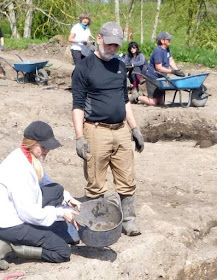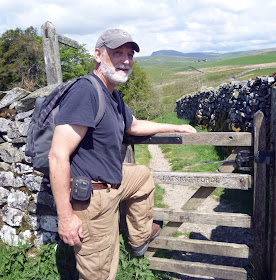Alas, as described in an 1827 edition of "A History of Northumbria", the statue was intentionally chopped off at the waist. The farmer who owned the land was quite fond of it but his son - who comes across as an unpleasant lout - got tired of people walking across their land to see it and had Robin's upper half cut up into stone gateposts. Here's Robin today.
Nearby is a modern reconstruction of what he used to look like. This is half scale, so Robin is a Halfling in more than one sense. He is suspected of being a British influenced version of Sylvanus, the forest god, but various other interpretations have been put forth.
The first photo I show here is a "before" picture. Robin had accumulated a pretty good coating of the local moss. We had a discussion about whether pulling this off versus leaving it on is better for the long term survival of the structure. Below you can see the decision.
To be honest without the modern reconstruction you could interpret this a couple of ways. My first thought was that Robin of Risingham was facing backwards here....basically mooning us. As sometimes happens this led to another discussion. It seems that one or two individuals on the excavation site could benefit - oh, hell, the entire crew would be the beneficiaries - of longer tailed shirts for bending over while working. I present without further comment a link to a company that might perhaps be contracted to provide special variants for the official excavation T-shirts we all receive on our first day of work......




















































